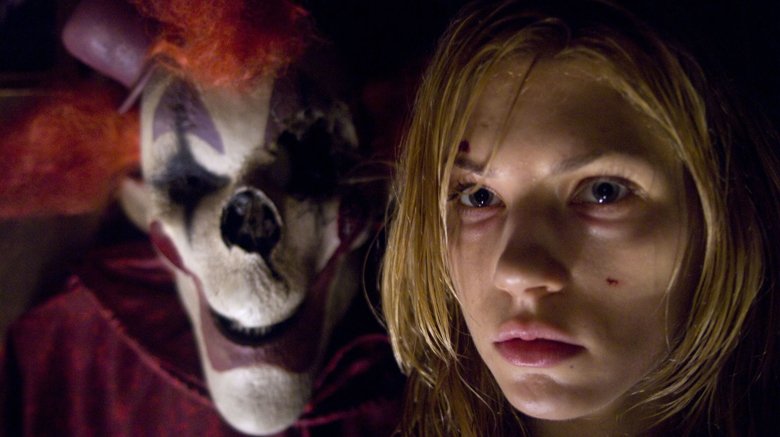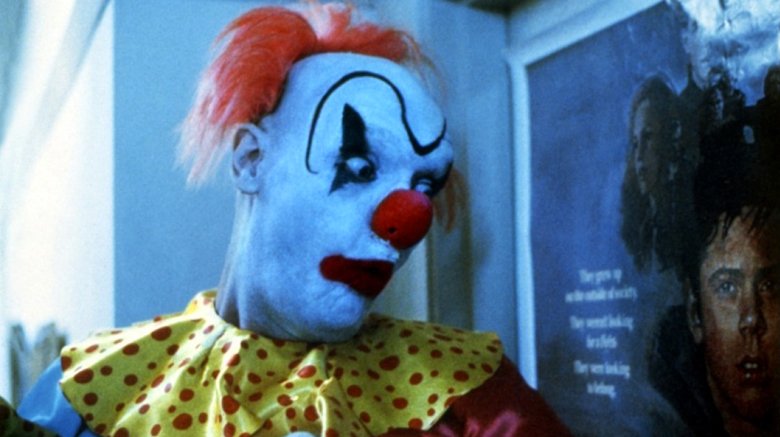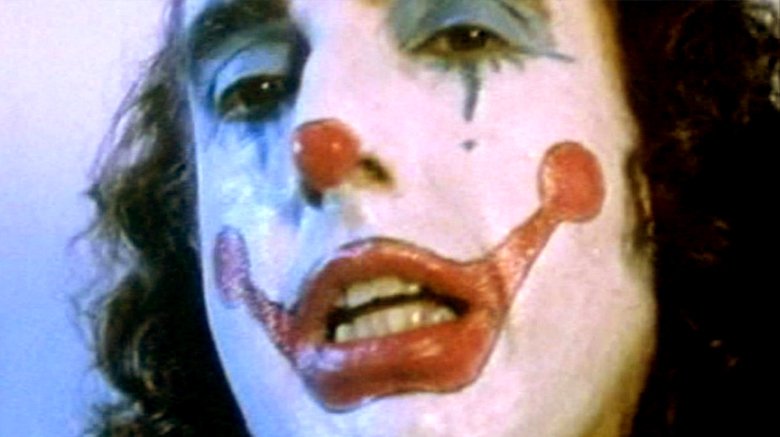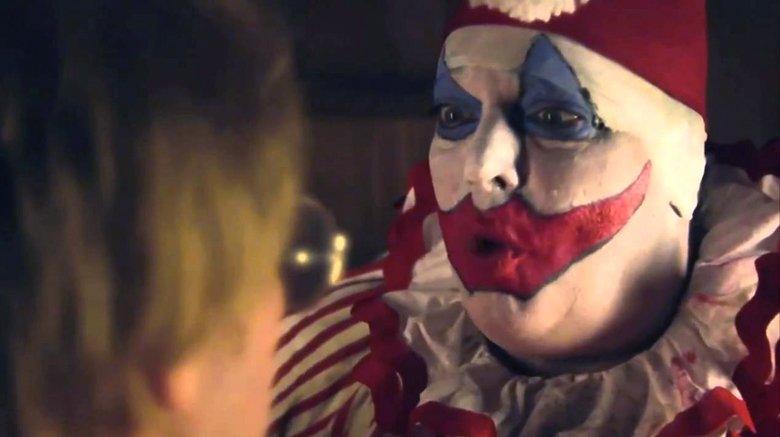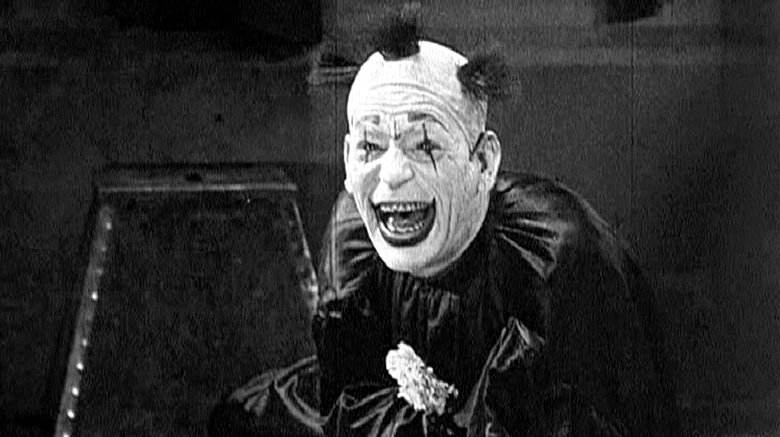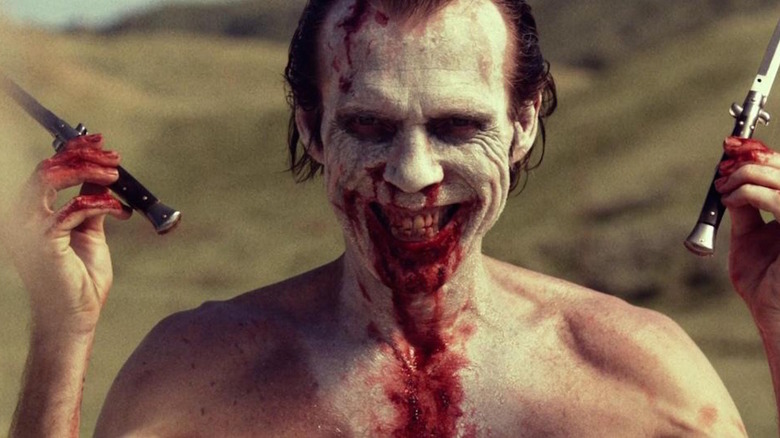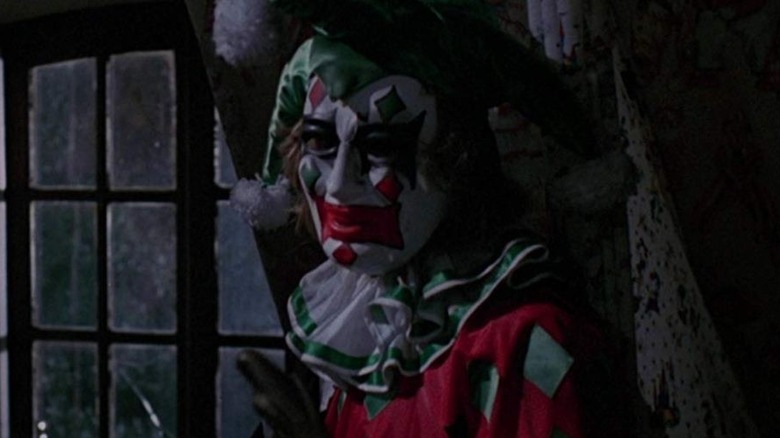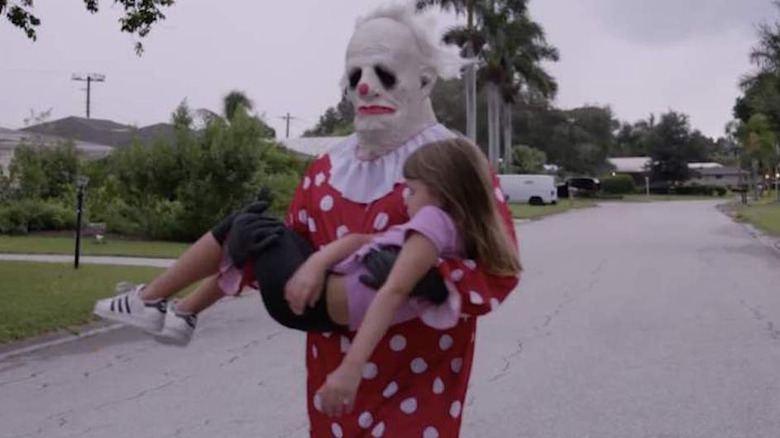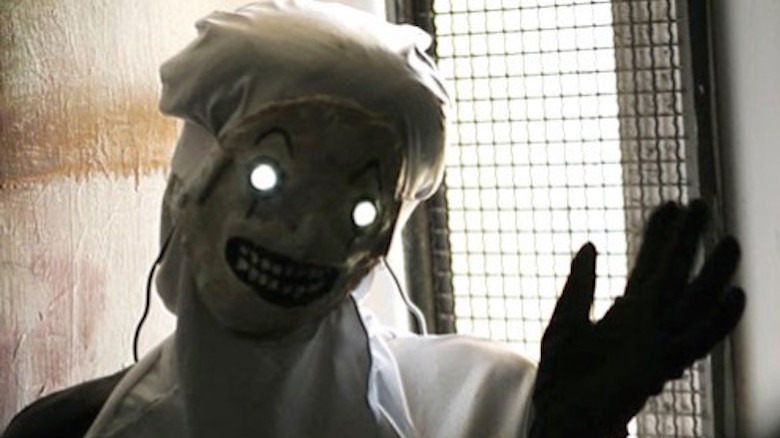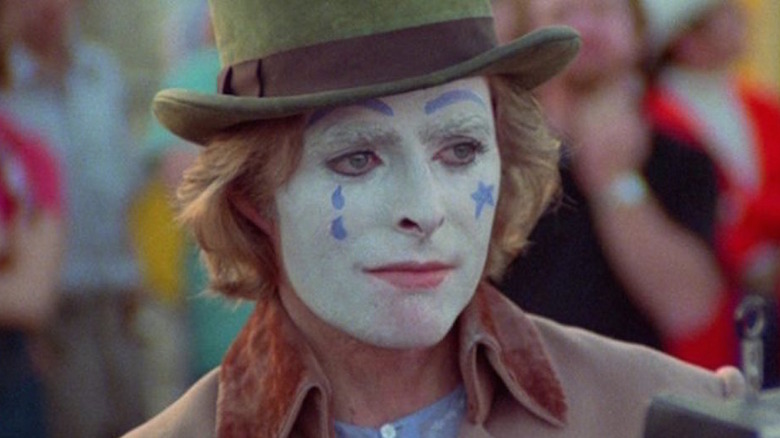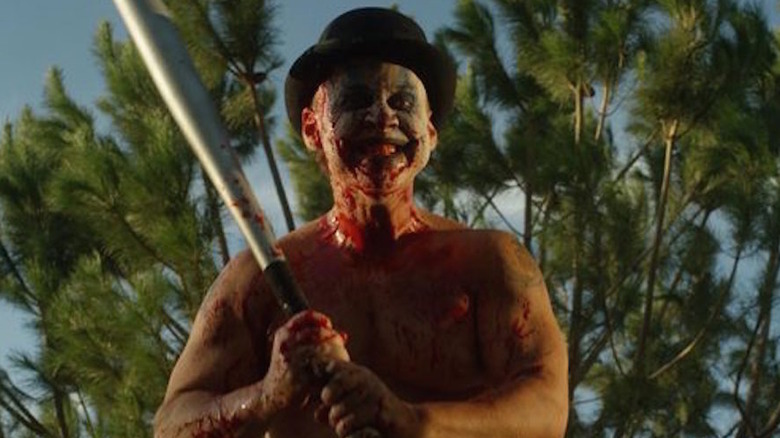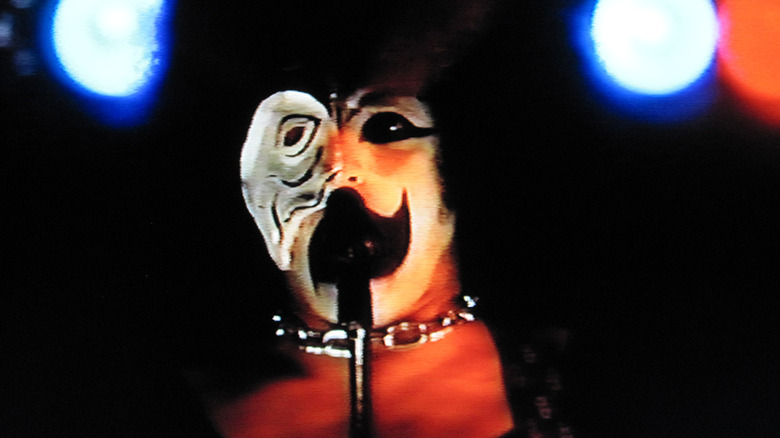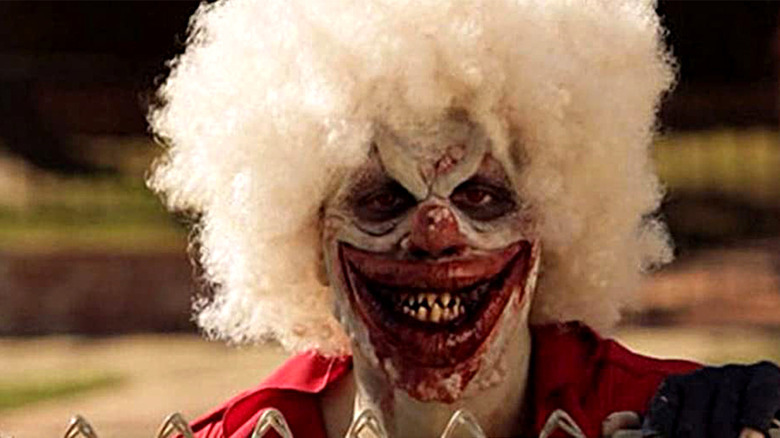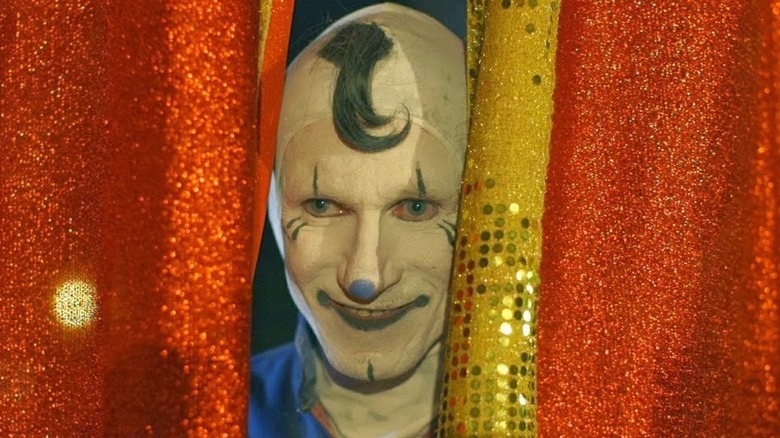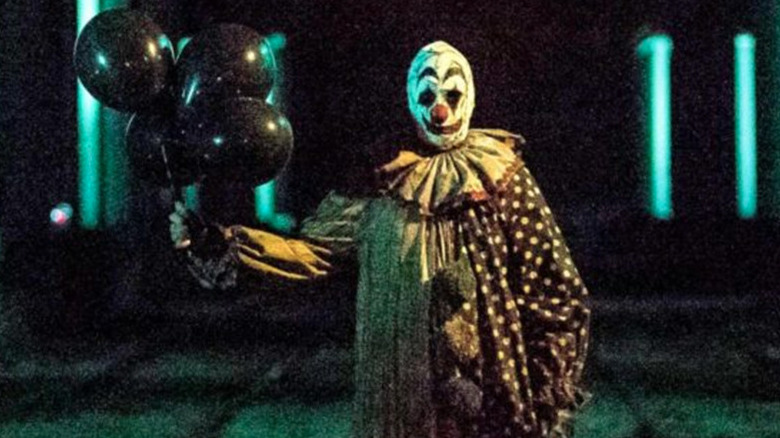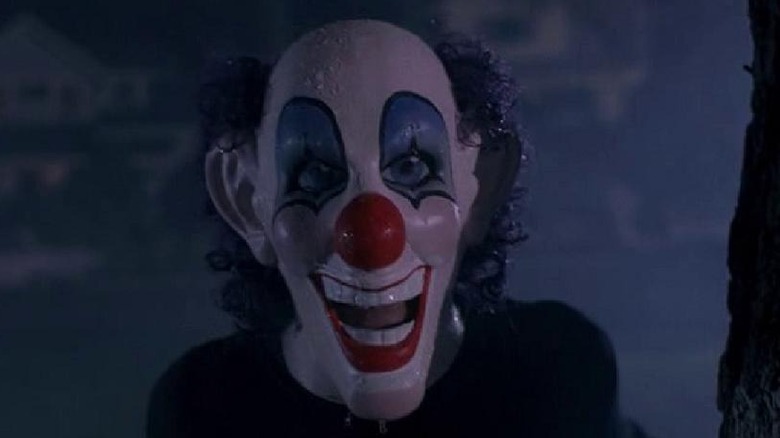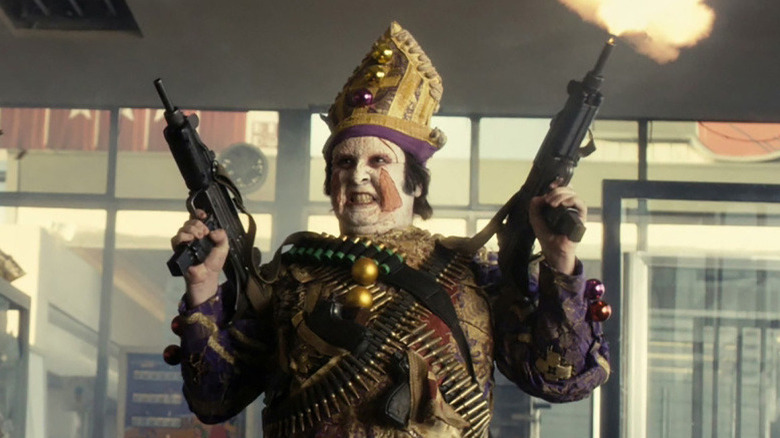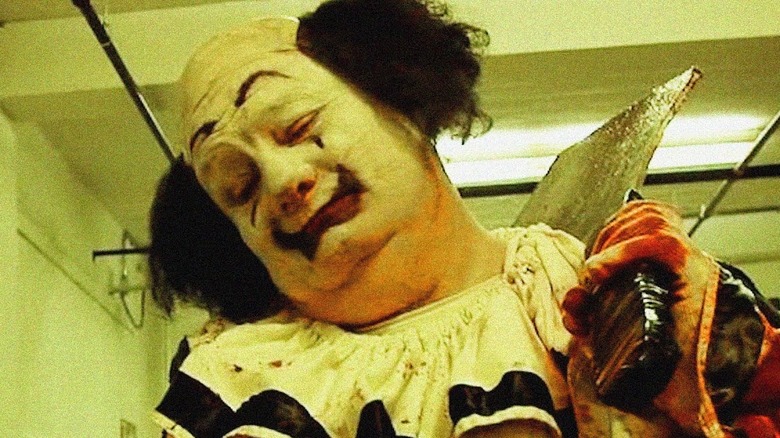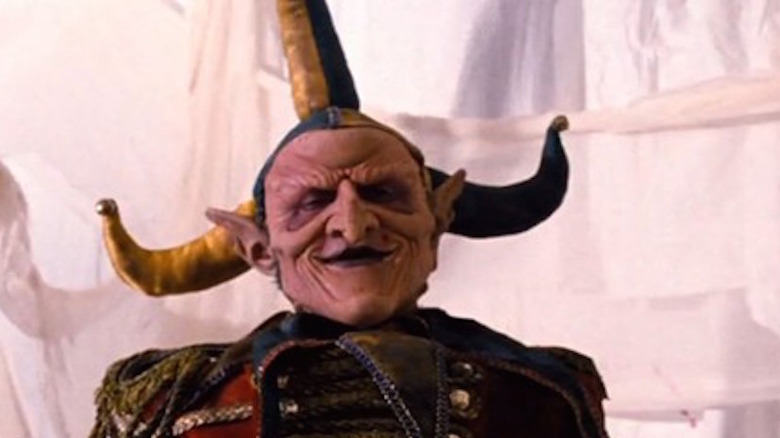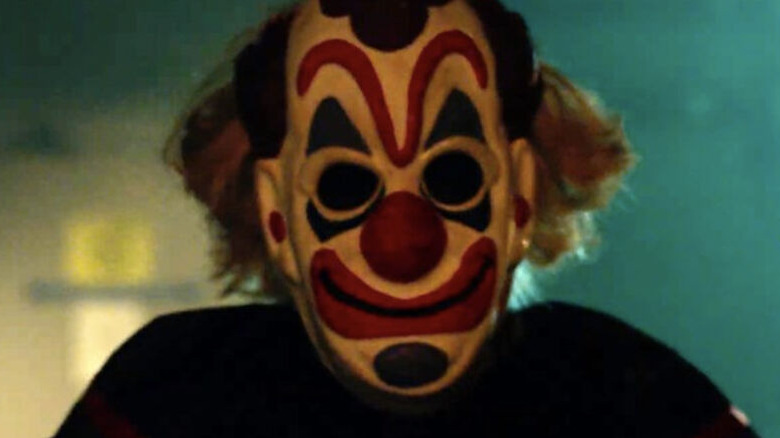Terrifying Clown Movies You Never Knew Existed
In Stephen King's It, the demonic clown Pennywise has always been a presence in the town of Derry, terrorizing its children for as long as humans have lived in the area. This year, a new version of It is coming to the big screen, featuring Bill Skarsgård as the immortal evil being, a role previously associated with legendary actor Tim Curry, who played the part in the 1990 TV miniseries.
But just as Pennywise has many faces, the terrifying monster clown is too big an idea for just one franchise, and creepy clowns have appeared in a wide variety of movies over the years. Sometimes, it's just a human killer in makeup; sometimes, like in It, it's a demonic force. Some of the clowns are even aliens. And in some movies, you might find yourself rooting for the clown as he pursues people who deserve his wrath.
So without further ado, here are some more movies featuring deadly clowns you might not have met—and who may haunt your nightmares once you do.
Clown
Kent's just a regular guy, but when his son's birthday party is almost ruined after the clown cancels, Kent puts on an old suit and plays the role himself. Unfortunately, the suit is cursed; not only can he not take it off, but he starts transforming into a demonic clown with an insatiable need to eat the flesh of children. As the clown takes over, all traces of Kent disappear and he becomes a truly terrifying creature, complete with white skin, red nose, and multi-colored hair.
Brought to you by future Spider-Man: Homecoming director Jon Watts, Clown was shot in 2012, but it took until 2016 to find distribution in the U.S. It's a genuinely disturbing film, featuring one of the most terrifyingly inhuman clowns ever to appear onscreen.
Stitches
Stitches wasn't a very good clown to begin with, but his career—and his life—ended when some kids tied his shoelaces together and he fell onto an upturned knife and died. Six years later, those kids are teenagers having a party in the same house, and Stitches rises again to take his revenge. He has the same bad attitude he always did, but now he's a lot more murderous.
An Irish production directed by Conor McMahon, Stitches was released in 2012. The part of the sarcastic undead clown was played by successful UK comedian Ross Noble.
All Hallows' Eve
Art the Clown is a force for chaos and evil, his human origin (if he has one) unknown. In one segment of the anthology All Hallows' Eve, he's a literal agent of Satan. In another, he's just an image that looms over an assault by aliens. And in the third, he's a mysterious killer obsessed with dismembering his victims. He also appears in the framing sequence of the movie, in which a babysitter working on Halloween finds a videotape of Art's ghoulish deeds in a kid's Trick or Treat bag.
All Hallows' Eve director Damien Leone created Art years before the movie's 2013 release; the monstrous clown, as played by Mike Gianelli, appeared in Leone's short films Terrifier and The 9th Circle, both of which he then incorporated into All Hallow's Eve, with the addition of a third short segment and a framing sequence. Art the Clown is set to return in Leone's next film, a feature-length version of Terrifier.
Amusement
Before he became the masked clown known only as the Laugh, this movie's main character was a psychologically unbalanced child who faced bullying at the hands of three girls who made fun of him. Now that they're all grown, he's dressed as a clown to hunt them down and take revenge. Amusement, a 2008 film directed by John Simpson, is split into sections focusing on each of the girls attempting to escape from the Laugh's violent wrath. Only at the end of the film does their childhood connection come to light. Keir O'Donnell's face is hidden, but it's his actual laugh that runs through the film as an unmistakable presence.
Prank
Prank, an indie film from 2013, comes at the murderous clown idea from a very different direction. In this one, it's the protagonists who dress up like clowns to take revenge on their bullies from high school. As the title implies, it was only ever supposed to be a prank, but when a bully dies, things rapidly spiral out of control. Facing a killer clown is one thing, but how would it feel to have to face the fact that you've inadvertently become one yourself? Director Yiuwing Lam forces the viewer to put themselves in the blood-soaked clown shoes.
Clownhouse
Cheezo, Bippo, and Dippo are just regular clowns—albeit ones who are murdered by three escaped mental patients, who then don their costumes and makeup. The trio of murderous counterfeit clowns follow three young brothers home from the circus and stalk them while they're alone in their isolated house. One of the brothers even calls the cops, but "the clowns from the circus are coming to get me!" doesn't sound very believable. It's basically the perfect setup for a low-budget 1989 horror movie: three killer clowns versus three teenage brothers in one big empty house. Hence, Clownhouse.
Unfortunately, the real-life circumstances of Clownhouse's production turned out to be far more disturbing than its story. Director Victor Salva was convicted of sexually abusing the actor who played the youngest brother, which took place while the movie was shooting, and the story resurfaced when Salva, after a brief prison stay, was hired by Disney to direct Powder in 1995. Anyone who knows the story is understandably going to find Clownhouse hard to watch. There are much worse things in the real world, it turns out, than psycho clowns.
Blood Harvest
Mervo the Marvelous is unique among the clowns on this list—he's not necessarily the killer in Blood Harvest, he's just hanging around, being incredibly creepy, in the town where the killings are happening. (He's also played by Tiny Tim, the falsetto-singing ukulele player best known for performing "Tiptoe Through the Tulips.") Mervo is the older brother of the ex-boyfriend of Jill, the film's protagonist. When everyone she cares about starts dying, Mervo is only one of the possible suspects, although when people are mysteriously dropping dead, being the town eccentric who always wears clown facepaint is not a great look.
Director Bill Rebane approached Tiny Tim about appearing in a horror film after seeing him perform live. Blood Harvest turned out to be more of a footnote than a bright spot in the strange performer's unusual career, but it's certainly weird enough to be worth a look for enthusiasts of the clown horror subgenre.
Vulgar
Vulgar the Clown is probably best remembered as an animated mascot who appeared in the original logo for View Askew Productions, writer-director Kevin Smith's production company. When the lingerie-clad clown eventually got his own film in 2000, it turned out to be a truly dark and twisted affair. When Vulgar decides to commit murder, it's for very sympathetic reasons, as he's planning revenge on the men who sexually assaulted him and are now extorting him. The real question, as the film reaches its climax, is whether Vulgar is ready to let himself because a truly murderous clown, or whether he can hold on to his humanity despite his trauma.
Vulgar was produced by Kevin Smith, directed by Bryan Johnson, and stars Brian O'Halloran, best known as Dante from Clerks, in the title role. It's a very dark blip in the early history of View Askew, which otherwise specialized in stoner comedies until Smith started exploring the horror genre himself with 2011's Red State.
The Clown at Midnight
Pagliacci is an opera about a clown, and the lead in that opera supposedly murdered opera singer Lorraine Sedgewick years ago, which is still giving her now-teenage daughter Kate nightmares about killer clowns. Kate's friend Monica convinces her to help restore the opera house where her mother was killed, but of course they and they're friends are stalked by a murderous figure in the Pagliacci costume, because the basic premise of a slasher movie is that the killer will always come back.
The Clown at Midnight was directed by Jean Pellerin, a filmmaker best known for heavy metal videos, and features Tatyana Ali, better known as Ashley Banks from The Fresh Prince of Bel Air.
Killer Klowns from Outer Space
Killer Klowns from Outer Space became a cult classic after its 1988 release, but it's not as widely remembered or beloved as it once was. As the title implies, it tells the story of clownlike aliens who arrive on Earth in flying saucers that look like circus tents and begin massacring and even devouring all the humans they find, often in ridiculous ways that resemble circus performances. Only a young man named Mike and his gang of friends have a chance of stopping the monstrous clowns, but the creatures prove terribly resilient.
Killer Klowns from Outer Space was the only film written and directed by the Chiodo Brothers, special effects artists who also created the titular monsters for the Critters movies as well as providing Large Marge's memorable monster face in Pee-Wee's Big Adventure.
Gacy
John Wayne Gacy is perhaps the scariest killer clown of all, for the simple reason that he actually existed. A family man and respected community member, Gacy turned out to have the bodies of more than 30 men and boys buried underneath his house, having murdered them usually after first sexually assaulting and sometimes torturing them. He owned a construction company, but also performed as a clown on a volunteer basis. It's the images of Gacy as a clown that have become ubiquitous in discussions of the murders, for the simple fact that clowns are so unnerving.
The biopic Gacy came out in 2003, directed by Clive Saunders and starring Mark Holton. It's not a widely remembered or popular film, but if you're interested in true crime or killer clowns, it's a must-see.
He Who Gets Slapped
He Who Gets Slapped is a 1924 silent film starring Lon Chaney as the titular clown, whose entire act is being slapped and humiliated by the other clowns. He was once an inventor, but had his ideas stolen and his career ruined, leading to his new job as a constant object of humiliation. When the man who originally betrayed him arrives at the circus with designs on the woman he loves, the clown realizes his time for revenge has arrived.
Victor Sjöström directed He Who Gets Slapped as an old-fashioned melodrama, but horror legend Lon Chaney brings an unspeakably creepy quality to the revenge-obsessed clown at the story's center. He might not have been the first terrifying clown in cinema history, but he's certainly a memorable one, and proves that the archetype has been around for very, very long time.
31
Rob Zombie initially promoted his survival horror feature "31" back in 2014 with an image of a blood-streaked clown face, which prompted some fans to surmise that it was a stand-alone adventure for Sid Haig's Captain Spaulding, the deranged clown from "House of 1000 Corpses" and "The Devil's Rejects," among other Zombie films. The Captain was absent when "31" made it to theaters in 2016 (via crowdfunding efforts), but a new crop of killer clowns was on hand to bedevil his heroes, a quintet of carnival workers kidnapped by psychopaths in aristocratic drag to fight for their lives in an elaborate funhouse maze called Murder World.
The clowns in "31" are a motley crew of killing machines known as the Heads, and identified largely by words on their bondage and metal-inspired outfits: Death-Head (Torsten Voges), Sex-Head (E.G. Daily), and so on. The Big Bad among the bunch is Richard Brake's gaunt Doom-Head, who issues doom-laded monologues before slaughtering his victims. Brake is a mesmerizing presence in and out of Zombie's features (he was the Night King on "Game of Thrones" and appeared in films like "Barbarian" and "Mandy") and he and his fellow Heads elevate "31" with their wholly committed lunacy whenever Zombie's penchant for '70s horror tropes and pulp dialogue feel stale.
The House on Sorority Row
Don't let the sleazy one-sheet art or the presence of "Real Housewives of Beverly Hills" star Eileen Davidson scare you away from "The House on Sorority Row." Though released at the tail end of the subgenre's cycle in 1982, it balances an impressive amount of gore (including a jaw-dropping severed-head-in-a-toilet gag) and on-screen shenanigans with a surprising amount of suspense and script smarts thanks to co-writer/producer/director Mark Rosman. Now a prolific TV helmer, Rosman studied filmmaking under Brian De Palma at New York University and served as assistant director on his 1980 comedy "Home Movies."
It also features a relentless silent killer (Carlos Serio, billed as Charles) dressed in a supremely creepy jester mask and costume — not technically a clown but certainly clown adjacent — who stalks seven sorority sisters at an unnamed college. The killer is saddled with a tasteless back story — he was mentally and physically disabled at birth due to his mother's use of an experimental fertility drug — but his unnerving presence, as well as a wealth of grisly kills, stylish photography, and a cast anchored by women who aren't just targets, help "House on Sorority Row" stand out from the rest of the '80s slasher pack and from its unnecessary 2009 remake.
Wrinkles the Clown
The 2019 documentary "Wrinkles the Clown" opens with grainy video footage that appears to show every child's nightmare: a sleeping girl is visited by a disheveled, black-eyed clown that emerges from under her bed. The intruder is Wrinkles the Clown, a strange figure that surfaced in Florida in 2014, promising to honor parents' requests to frighten misbehaving children for a fee. Stickers advertising Wrinkles' services papered the Sunshine State, and additional videos showed Wrinkles lurking outside homes and scaring kids silly.
Wrinkles briefly became a pop culture sensation, inspiring news coverage, talk show gags, and even serious discussion about the stigma attached to clowns (and parents who would hire one to scare their kids). The truth about Wrinkles, however, proved even weirder. In the film, director Michael Beach Nichols reveals what he believes to be the real Wrinkles: a retiree who donned the grease paint for the money.
But the retiree was revealed to be an actor hired by the "real" Wrinkles, who reportedly created the character and videos as part of a performance art project. A feature in the Naples Daily News opined that the "real" Wrinkles was former clown Cary Longchamps, who had attempted to raise funds for his own Wrinkles documentary – allegations that Longchamps denied. Though Wrinkles sightings have dropped off since 2019, those videos retain the power to creep out viewers of all ages.
Judy
The Judy referenced in the title of this 2014 indie chiller is not its protagonist, Mary, (Orietta Babusci), but rather Mary's adorable dog, whose disappearance is one of the first signs that her chance encounter with deranged, clown-faced street performer Ursula (Mariagrazia Giorgi) will soon turn from bad to terrifying. Ursula is first seen dragging a spike-covered box that contains an unnerving puppet named Mr. Scissor – yes, "Judy" has both horrible clowns and hand puppets — before she and her clown-drag pals, the Crows, brutally murder an assistant (also played by Babusci) for daring to look into Mr. Scissor's container without permission.
Plot logic takes a back seat to the atmosphere in "Judy," which was released by Italian horror media company Necrostorm; their go-to approach for fright material — extreme gore — is also notably restrained here. The focus is instead on suspense and slow-mounting paranoia: writer-director Emanuele De Santi would rather keep you guessing about the borders between reality and paranoia (are Ursula and the Crows really after Mary? What's the story with Mr. Scissor? And how come we can hear Judy but not see her) than hammer you with gruesome special effects. "Judy" is a stylish effort that could find favor with the hardcore horror crowd and fans of arthouse fare alike.
The Premonition
You know that you're in for a singular and strange movie experience within the first few minutes of the 1976 supernatural thriller "The Premonition." No sooner have the opening credits unfurled than we are treated with the sight of '70s go-to bad guy Richard Lynch who, as a carnival clown and recent mental hospital patient, performing a stylized dance number to no audible music. To the credit of Lynch, co-writer-director Robert Allen Schnitzer, and co-writer Anthony Mahon, the scene is more haunting and touching than weird, which also sums up "The Premonition."
Lynch's clown, Jude, has teamed with fellow ex-patient Andrea (stage actress Ellen Barber) to kidnap her daughter, who is being raised by the middle-class Bennetts (Sharon Farrell and Edward Bell). Their plan works but the effort leaves Andrea unhinged, prompting the equally troubled Jude to murder her. Meanwhile, Farrell's Sheri experiences disturbing visions that draw her closer to Jude, her daughter, and the location of Andrea's body.
Terrifying is maybe too strong a term for "The Premonition," but it has an undeniably eerie vibe and several setpieces that will raise shivers, especially when Sheri is drawn by her premonitions to a lake, unaware that Andrea's body is there. Lynch's unstable Jude echoes the film's mournful vibe: as historian Stephen Thrower notes in his book "Nightmare USA" Lynch emits an unearthly moan when he loses control, but the sound is more heartbreaking than horrific.
Clown Fear
In 2020's "Clown Fear," bride-to-be Carlee (co-writer Sadie Katz) is stiffed at the altar by her fiancé, prompting her and her wedding party of frenemies to turn the affair into a debauched girls' weekend in Las Vegas. Their road trip is cut short by car trouble, which lands them in a tiny desert town with a clown-themed motel. As it turns out, the clown aesthetic extends to the entire town, which is populated by homicidally deranged descendants of circus clowns and carnival workers that take a narrow (read: murderous) view of outsiders.
"Clown Fear" has a runtime of nearly two hours, which is far too long for a premise that essentially boils down to "crazy clowns want to kill outsiders." But Katz and co-writer and director Minh Collins understand that any script deficiencies can be overcome by an abundance of vicious murder setpieces and a visual palette built on the three G's of grindhouse aesthetics (grime, gore, and gross behavior). The clown killers are an appropriately over-the-top crew that evoke, in both behavior and appearance, the bonkers backwoods and desert dwellers in films like "Two Thousand Maniacs!" and Wes Craven's original "Hills Have Eyes."
Terror on Tour
Say what you will about 1980's "Terror on Tour" — that it's cheaply produced, atrociously acted, and in its final moments, flails wildly to make sense from the revelation of the killer's identity — but the film, directed by Grindhouse legend Don Edmonds ("Ilsa, She-Wolf of the SS") and written by Alex Rebar (star of "The Incredible Melting Man") attempts to deliver something different within the slasher template. And yes, what it comes up with is a KISS-style rock band in clown makeup that is accused of killing their fans. But you can't say it's a premise that's been done to death.
The band itself — dubbed the Clowns and played by the members of a real Illinois power-pop act called the Names – are both creepy and ridiculous in their frizzy fright wigs and leotards, but their stage act, which features simulated killings a la Alice Cooper's stage act, is startling upon first glimpses. The killer is revealed to be the band's manager (Larry Thomas, "Seinfeld's" Soup Nazi), who delivers an unhinged rant con gusto that reveals his homicidal motivations (mother issues are again the culprit). Thomas later apologized for his performance on the film's IMDB page, but he shouldn't have made the effort: he manages to inject a real, live-wire dose of insanity into the proceedings.
Scary or Die
The 2012 horror anthology film "Scary or Die" is, like many other portmanteau films, a mixed bag of effective and underfed vignettes that offer up either scares or laughs (though it should be noted that a few of the latter are actually deliberate). It's saddled with a silly framing device — its stories are posted on a sort of morbid take on the "Funny or Die" site — but two stories make an attempt at depth by folding real-world issues (specifically, immigration) into the horror elements. However, its best segment offers its own take on "Clown's" central conceit.
In "Clowned," Corbin Bleu of "High School Musical" fame plays against type as a drug dealer who plies his wares in order to provide for his mom and younger brother. That familial devotion is put to the test after he's bitten by a clown at his sibling's birthday party (!) and begins to slowly sprout clown features: frizzy hair, greasepaint skin, and a loud outfit. In short, he becomes a were-clown – a premise seemingly custom-built for cheap laughs, but as in "Clown," it's played straight and scary by Bleu and writer-director Michael Emanuel. Giving Bleu's character a younger brother is a particularly shrewd bid for added suspense since Bleu's final transformation includes an appetite for grade schoolers.
Circus of the Dead
It should go without saying that a horror movie about a murderous, psychopathic clown is going to have scenes of violence in it. That certainly applies to all of the films in this list, but few aside from the "Terrifier" series approach the degree of carnage seen in 2014's "Circus of the Dead." Co-writer, producer, and director Billy "Bloody Bill" Pon — who also tackled vicious killer clowns in his 2010 short "Doll Boy" — spares no quarter in depicting extreme savagery carried out by a group of deranged circus clowns who force a troubled father (Parrish Randall) to play sadistic games in order to save his daughters. The violence here is bloody (courtesy of Marcus Koch's special effects) and brutal — the kill sprees in "The Devil's Rejects" pale in comparison — and dismisses any sense of dark humor associated with clowns carrying out the acts.
The violence is grounded somewhat in the story, which suggests that the cruel actions of clown leader Papa Corn (Bill Oberst Jr., who's also in "Scary or Die") and his minions are some kind of rough justice handed down to unpunished sinners. That idea waxes and wanes throughout the film, though the body count continues to mount; it's also worth noting that some of the violence is sexual in nature, which may make "Circus of the Dead" palatable to only hardcore horror fans.
Gags the Clown
A silent clown toting a fistful of black balloons appears on the streets of Green Bay, Wisconsin, prompting a cross-section of curious types; a dogged TV reporter (horror vet Lauren Ashley Carter of "The Woman"), two cops, a trio of joy-riding teens, and a hard-nosed podcaster, to seek out the interloper and determine what he wants. To their everlasting regret, Gags, as the clown becomes known, has dark designs on the town's population and anyone who attempts to get in his way.
"Gags the Clown" expands on writer-director Adam Krause's 2016 found-footage horror short "Gags," which he promoted through social media posts purporting to show a real evil clown lurking on the streets of Green Bay. The attention afforded to the posts led to a feature-length version that retains the found footage approach while expanding the number of potential victims on Gags' trail. Krause makes excellent use of glitchy CCTV and security cam footage to underscore Gags' supernatural qualities, but it's the clown itself (Eric Heuvelman) that really delivers the shivers. Gags is an almost entirely silent and still presence, barely interacting with the other characters until the freaky final scene. That lack of "clowning" behavior proves more unsettling than any of the capering maniacs in other clown horror pics.
Out of the Dark
The killer clown subgenre doesn't allow for a lot of creative freedom – filmmakers are essentially required to feature a clown delivering some variation on slasher film tropes – but the 1989 thriller "Out of the Dark" displays impressive genre cross-pollination within its very weird framing device. At first blush, it plays like sleazy exploitation, focusing on a clown-masked killer named Bobo who's preying on the extreme types that orbit a phone sex service. But the script by J. Greg De Felice and Zane W. Levitt (a prolific indie producer) quickly turns into a funhouse mirror reflection of cheapjack horror, adding layers of dark and weird humor, and even a few legitimately tense moments. The end result may not satisfy those looking for a straight-ahead stalk-and-slash fare, but genre fans that appreciate some quirks will find "Out of the Dark" refreshingly offbeat.
The cast adds immeasurably to the off-kilter aesthetic: Director Michael Schroeder seems to share John Waters' affection for actors with eccentric or larger-than-life personas on and off-screen. The presence of Waters' late muse, Divine, who plays a man in his last film appearance, and her "Polyester" co-star, Tab Hunter, seem to confirm the connection, as do oddball specialists Tracey Walter ("Repo Man") and Bud Cort ("Harold and Maude"), "Eating Raoul" director Paul Bartel, "Valley Girl" co-star Cameron Dye, and Oscar nominee turned cult favorite Karen Black.
The Last Circus
Spanish director Álex de la Iglesia's two-decade career is marked by a consistent drive to push the boundaries of established film genres with extremes; his horror efforts like "The Day of the Beast" or the series "30 Coins" have comic or adventurous elements, while comedies like "The Bar" and "Perfect Strangers" include bizarre or unsettling circumstances. His 2010 film "The Last Circus" is no exception, as its elaborate story about warring clowns draws on many different influences, from political satire to apocalyptic fantasy and dark comedy.
The clowns in question are Javier (Carlos Areces), whose tragic past — his father, also a clown, was forced by government forces to murder opposition soldiers during the Spanish Civil War — makes him the ideal choice for the "sad clown" in a traveling circus. The troupe's "happy clown," Sergio (Antonio de la Torre) is a monster who abuses his trapeze artist girlfriend (Carolina Bang), with whom Javier is in love. Their respective passions lead to a pair of fights that leave both men horribly disfigured and in Javier's case, deranged; their rivalry soon takes on new (and literal) heights of insanity that leads to a clown faceoff at a 500-foot cross that memorializes Spanish Civil War casualties. "The Last Circus" is, like all of de la Iglesias's films, unclassifiable and unforgettable, and earned the Silver Lion, Golden Osella, and Young Artist Awards at the Cannes Film Festival in 2010.
100 Tears
Marcus Koch, who handled the grisly special effects for "Circus of the Dead" (among many other indie horror titles), also directed his own clown horror title, "100 Tears," which somehow manages to outdo even the catalog of cruelties he oversaw for Bloody Bill Pon's feature. "100 Tears" has a bare-bones plot: a pair of tabloid reporters (Georgia Chris and Joe Davison, who also wrote the film) pursue the Teardrop Killer (Jack Amos), a former circus clown turned psychopathic killer – that provides just enough framework for Koch to craft wall-to-wall, NC-17 rated splatter sequences.
The swath of carnage cut through the supporting cast by Amos' Grundy the Clown is at times breathtaking in its hideousness: characters are disemboweled, carved into sections, whacked by Grundy's comically huge cleaver in very personal places, and in one scene, a wheelchair-bound girl is decapitated and then pushed down a flight of stairs. The platonic banter between Chris and Davison has some comic bite, and there's a late-inning appearance by Raine Brown as Grundy's daughter that kicks the film into an even crazier territory, but "100 Tears" is focused squarely on the gore, the whole gore, and nothing but the gore. Art the Clown would surely approve.
Funny Man
Horror legend Sir Christopher Lee shares top billing for the 1994 UK horror release, but his actual screen time amounts to little more than a glorified cameo. The real star of "Funny Man" is actor Tim James, who plays the title character, a monstrous jester and clown who resembles the sadistic puppet Punch and works overtime to crack Freddy Krueger-style jokes while slaughtering the new occupants of Lee's stately ancestral home. Your mileage may vary in regard to James's puns, but there's no question that his tastes in murder hew towards the extreme: characters are beheaded, blown to smithereens, and stabbed in the eye with a high-heeled shoe.
Pauline Black, the singer for the '80s ska band The Selecter, gets turned inside out by the Funny Man, and two children also meet surprisingly ugly on-screen demises. all of which are detailed in lovingly grotesque ways. The inventive gruesomeness of the kill scenes helps to balance out James's barrage of groaners (some of which, according to Fangoria, were improvised), as does the ending, which tosses laughs aside (briefly) for a dose of pure nihilism.
Haunt
Extreme haunted house attractions — the ones that seek to terrify or disgust, not entertain — have been the subject of several films, most notably the two "Houses October Built" films and indie titles like "Hell Fest." Most have been forgettable efforts sunk by low budgets and lack of imagination, but 2019's "Haunt" is a satisfying shocker that delivers a wealth of chills as well as an accurate approximation of the extreme haunt experience. It also features a killer clown (Justin Marxen) who leads a handful of similarly masked assailants that turn the haunt's torture chamber and surgical theater sets into real slaughterhouses.
Haunted house films need a central location with plenty of spookshow style, and slasher pics work best when the killers in question are more than just hulking ciphers with power tools. "Haunt" boasts both: the deliberately disorienting production design for the extreme haunt is a haunted house fan's dream (or nightmare), and the clown and his minions have a disturbing origin story that surpasses the usual how-to-make-a-slasher tropes. Written and directed by "Quiet Place" scribes Scott Beck and Bryan Woods and co-produced by Eli Roth, "Haunt" is a creep show that deserves a wider audience.
